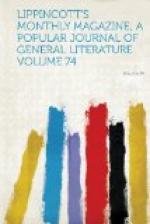fields and woods to see what manner of country we
are in. Bending our steps first toward the huge
old oak which seems to hang upon the very edge of
the green hill near the house, we suddenly find ourselves
just over a large basin enclosed with an octagonal
brick wall, except where the clear water runs out
over silvery gravel between curbings of heavy plank.
This is the spring, and a queer sort of spring it is.
Just under the tree-roots the water is but a few inches
deep over a bed of bluish-gray limestone, and in no
part of the basin, which is about twelve by twenty
feet, does it seem to be more than a half fathom in
depth. But just under the ledge of rock a shelving
hole slopes back under the hill, the bottom of which
no man has ever found. This hole is only about
three feet by two, and the narrow outlet to the basin
is but four inches deep, and loses itself within fifty
yards in an oozy bog. Yet, peering into the depth,
you catch a glimpse of the black head and beady white
eyes of a mudfish at least two feet long, and presently
of the silvery side of a three-pound bass which glides
across the opening. Drop a line with the cork
set at ten feet, and you will draw out of the very
bosom of the earth a mess of fat perch and bream each
as large and as thick as your hand, and eels three
feet in length are sometimes caught in the basin at
night. Two miles away, in the direction of the
“run,” there are on Woodboo plantation
two similar basins connected by a shallow streamlet,
and with no outlet which a minnow could navigate:
one of them is large enough for a little skiff to
float on, and the gray rock slopes down to a centre
depth of ten feet. Just where the sides meet is
a long, irregular fissure, out of which huge bass,
pike, jack and mudfish are constantly emerging, and
into which they retreat when disturbed. Hundreds
of perch, bream and young bass sport in the shallow
parts, and are easily caught with rod and line, the
water being so clear that you can watch the fish gorging
the bait, and strike when the entire hook disappears.
Now, where do these fish live? where do they breed?
and upon what do they feed? But the mystery does
not end there. About a mile in the opposite direction
as we walk through a little belt of wet pineland,
where the woodcock runs across our path or whistles
up from the wet leaves, we come suddenly upon a dozen
or more little basins, the largest not over six feet
by nine, which have no outlet whatever. One hole
about two feet in diameter goes sheer down between
two pine trees to a depth never yet fathomed:
you cannot see it until right on it, and you cannot
use a rod, but drop your line about twelve feet deep,
and your cork will go down like lead, while you pull
up red perch and blue bream until your arm wearies
of the sport. I have caught five dozen in a winter’s
afternoon, for the fish bite best in the coldest weather,
the temperature of the water being sixty-two degrees
the year round, irrespective of the weather.




